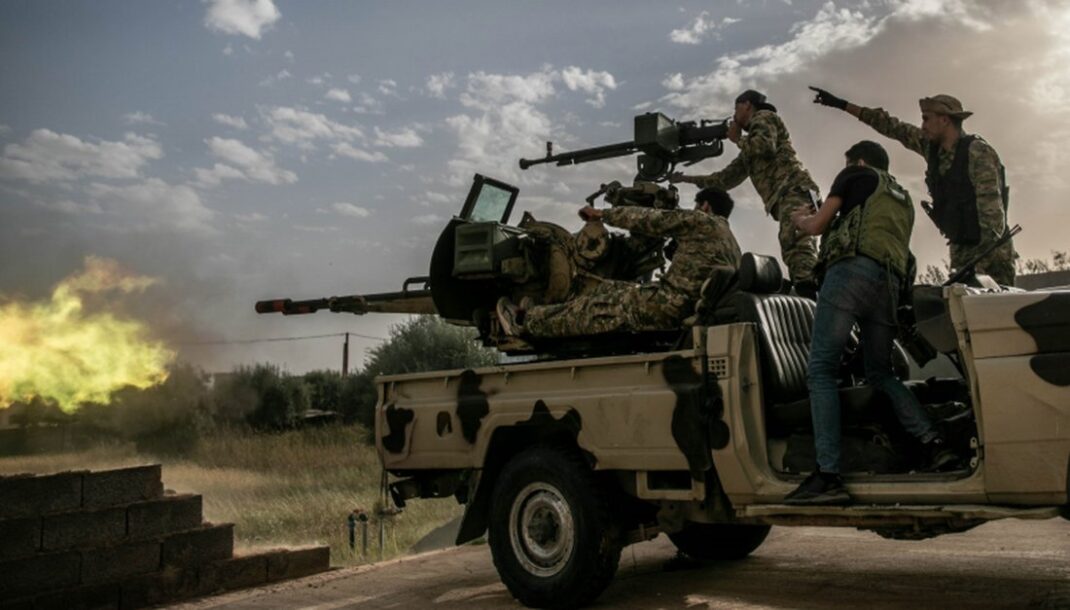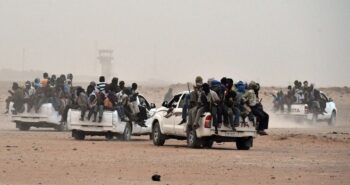By Emadeddin Badi
 Libya’s security sector has become virtually unrecognizable from what it was a decade ago owing to the transformations brought about since the 2011 revolution.
Libya’s security sector has become virtually unrecognizable from what it was a decade ago owing to the transformations brought about since the 2011 revolution.
This evolution has implications for any attempt to usher in short-term and interim security arrangements – including brokering ceasefires or improving security provision and policing capabilities – as well as longer-term security sector reform (SSR) efforts.
PART (V)
Social facets of Libya’s second civil war
The confluence of domestic dynamics with international developments outlined above, coupled with a significant degree of social polarization in 2014, led Libya to spiral into its second civil war.
Uncoordinated unilateral support to armed groups, half-hearted attempts at stabilization, European disunity, and Gulf rivalries in post-2011 Libya conflated to catalyse the eruption of civil war in 2014.
The events dovetailed with events in neighbouring Egypt, where Al-Sissi’s Emirati-backed coup had reverberations on the Libyan scene. Indeed, many within Libya’s Islamist milieu saw Khalifa Haftar’s attempted coup in February 2014 as an attempt to emulate Al-Sissi.
Months later, the Libya Dawn coalition was backed by Qatar, Sudan, and Turkey while Haftar’s authoritarian project – marketed as a purported “counterterrorism operation” — was launched in Benghazi with varying degrees of military support from the United Arab Emirates, Egypt, Saudi Arabia, France, and Jordan.
For Haftar, converting a thinly veiled power grab attempt in Tripoli into a counterterrorism operation launched from eastern Libya proved simple. Indeed, Benghazi was reeling from mounting tensions between local armed groups, causing a significant decline in security.
The grievances of eastern tribes, Gadaffi-era commanders, and even civil society activists were easy to co-opt, particularly since Haftar positioned himself quickly as a conduit for military support channelled via Abu Dhabi and Cairo.
Even armed group leaders that had a tapering effect on mounting tensions in Benghazi – such as Saiqa leader Wanis Bukhamada – opted to take Haftar’s side owing to the limited military support they received from authorities in Tripoli.
The hybrid security architecture of the revolution thus collapsed across the country, with fighting in Benghazi between groups that aligned with Haftar’s Operation Dignity, and those aligned against it.
Similarly, in Tripoli, fighting erupted between armed factions from Zintan – which aligned with Haftar’s then-Libyan National Army – and those opposed to Haftar, which coalesced into the Libya Dawn alliance.
For the second time since 2011, disparate armed groups formed a semi-cohesive coalition against a perceived threat – namely that a coup under Haftar was widely perceived as a relapse into authoritarianism.
In the fallout of the civil war that pitted Libya Dawn against Zintani forces aligned with Haftar’s Operation Dignity, political institutions split and rival power centres emerged in the east and west.
The ensuing severe financial crisis induced changes in the behaviour of armed actors,51 though it also heavily altered perceptions of armed actors’ social legitimacy among local communities.
Meanwhile, in Benghazi, Haftar had rallied support from disgruntled regime-era officials, federalists, tribes who perceived themselves as marginalized, and local constituencies that resented the climate of insecurity and impunity plaguing Benghazi and eastern Libya more broadly.
The few professional forces that joined Haftar had, by and large, aligned with him because they had been sidelined by the parallel security structures established after 2011. Haftar’s calls for the “youth to rise” in October 2014 to join the ranks of his “army” as support forces also resonated with sections of Benghazi society.
The alignment of influential Bedouin tribes in eastern Libya, such as the Awagir, with Haftar also reflected a communal grievance: indeed, underlying this mobilization was an oft-underplayed animosity between constituencies from poorer Bedouin tribes and wealthier families of Misratan origins.
The properties and businesses of the latter had been increasingly targeted by Bedouin tribal vigilantes, who sought to mobilize and act on these grievances.
Haftar exploited this class-based divide to rally economically disadvantaged Bedouin groups (predominantly Awagir sahawat) as “support forces” under the banner of his Operation Dignity; nevertheless, the fact that Islamic State (IS) affiliates emerged in the city in December 2014 and fought alongside Haftar’s opponents veiled these communal divides and retroactively legitimized the flawed counterterrorism narrative he used to derive support, co-opt grievances, and target opponents.
On the opposite end of the spectrum, forces that opposed Haftar identified as anti-Gadaffi and pro-revolution rather than Islamists, though they also included members of Ansar Al Sharia (AS), a US-designated terrorist group. In addition to AS, Libya Shield 1, the February 17th Brigade, the Rafallah al-Sahati Brigade, and the Brega Martyrs Brigade also mobilized against Haftar.
They organized themselves under the umbrella of the Benghazi Revolutionaries Shura Council (BRSC), a newly established entity that – with foreign backing and improved coordination – was able to push back against Haftar’s self-styled LNA for years in Benghazi.
Both Haftar’s LNA and anti-Haftar armed groups possessed their own degree of social legitimacy in the east. This partly explains why the fratricidal war of 2014 in Benghazi raged on for three years and had an extremely negative effect on the region’s social fabric.
Entire families were displaced from the east during and after Operation Dignity under the pretext of being terrorists – a sign of the degree of social embeddedness of the forces that opposed Haftar, as well as the motivations of opposing constituencies and tribes.
Many of these families originated from western Libya, revealing the darker undertow behind Operation Dignity and the reasons behind the mobilization of some of Haftar’s constituencies against his perceived opponents, which transcended simplistic “counterterrorism” aims.
The Saiqa Special Forces: A case of progressive hybridization
The Saiqa (or Thunderbolt Special Forces) is one of the very few forces that survived the Gadaffi regime era. Established in 1970 in the city of Benghazi, it was based on a decree from then-Lieutenant Abdel-Fattah Younis.
Trainers from Egypt were brought to Libya to help establish and train the force. On 19 February 2011 Younis announced his defection from the Gadaffi regime. The entire Saiqa Special Forces in Benghazi defected with him.
One day later, Saiqa attacked the Special Forces’ Fadil Bu Amr brigade in Benghazi (a Gadaffi-aligned force) and took control of its headquarters. The incident was one of the first military operations carried out by a brigade in the name of the February Revolution. Saiqa’s leader Abdel-Fattah Younis was assassinated in July 2011 in mysterious circumstances.
The suspected involvement of National Transitional Council figures and Islamist figures in his murder exacerbated pre-existing tensions between newly formed revolutionary battalions and Saiqa. Major General Wanis AlMabrouk Bukhamada took over the leadership of Saiqa after Younis.
In 2014 Bukhamada announced that Saiqa would participate in Haftar’s Operation Dignity in Benghazi. This was against a backdrop of tensions between Saiqa members along with the radical group Ansar Al Sharia, as well as the revolutionary-leaning February 17th Battalion, both of which sought to expand their military footprint in Benghazi following the fall of the Gadaffi regime.
Saiqa was one of the most prominent groups to play a fundamental role in Haftar’s takeover of Benghazi and the expulsion of his opponents; however, Saiqa was not solely composed of regular elements as the internal make-up of the force was subject to transformations mirroring political developments that affected the state in 2011 and 2014.
In 2013, against a backdrop of increasing assassinations,59 Abukhamada called on civilians to join Saiqa’s ranks; as a result, an estimated 800 individuals joined the ranks of the 300 professionally trained individuals who remained on duty after the fall of the Gadaffi regime.
Irregular fighters (former civilians) who joined Saiqa in 2013 served to buttress the group’s waning influence and averted its complete disintegration as other revolutionary and Islamist groups were garnering increased influence owing to the policies of the National Transitional Council and the GNC – which did not provide Saiqa with significant support.
Until 2013, Saiqa retained a role in deploying security units through “operation rooms” that formed the backbone of the hybrid interim security arrangements in Benghazi. Its leader, Bukhamada, even cooperated with Ansar Al-Sharia, publicly criticizing those who accused the group of being behind the wave of assassinations in Benghazi.
Nevertheless, the increasingly widening rift between pre-revolutionary and post-revolutionary armed groups in eastern Libya gradually grew wider, and Bukhamada’s persona was no longer influential enough to prevent it from affecting Saiqa. Haftar’s Operation Dignity – along with Bukhamada’s alignment with him – acted as a catalyst for the recruitment of irregular fighters – notably Salafis.
An estimated 1,700 untrained new recruits had joined Saiqa by the time the Libyan Arab Armed Forces (LAAF) had asserted control over Benghazi. These “former civilians” thus became the bulk of Saiqa’s rank and file, with a minority of regular professional soldiers acting as leaders and field commanders of the force.
In this sense, Operation Dignity completely altered the structure of Saiqa by establishing entire Saiqa-affiliated units staffed with volunteers. In addition to “support forces” – a mix of regular military “reservists” and civilians loosely tied to the LNA through an operation room that coordinated their battlefield movements – these newly established units were the main ground forces relied on by Haftar for his operations in Benghazi and Derna.
The massive number of individuals mobilized in a context of extreme social polarization – and the labelling of their opponents as extremists – further diminished the ability to command and control them. Most of these individuals mobilized according to “localist anchors” and, though some hail from influential Eastern tribes, tribal influence within Saiqa is minimal.
By contrast, the religious ideology of Salafi Madkhalism significantly influenced certain Saiqa units, most notably the 55th, headed by Major Mahmoud ElWerfalli. Salafi preachers framed the battle of Salafists against “terrorists” as a “Jihad against Kharijites”, essentially framing alignment with Haftar’s Operation Dignity as a sacred religious duty.
The confluence of these factors – the oversized recruitment of individuals as support forces by way of religious tropes – partly explains why LAAF units, particularly on civilians to join Saiqa’s ranks; as a result, an estimated 800 individuals joined the ranks of the 300 professionally trained individuals who remained on duty after the fall of the Gadaffi regime.
Irregular fighters (former civilians) who joined Saiqa in 2013 served to buttress the group’s waning influence and averted its complete disintegration as other revolutionary and Islamist groups were garnering increased influence owing to the policies of the National Transitional Council and the GNC – which did not provide Saiqa with significant support.
Until 2013, Saiqa retained a role in deploying security units through “operation rooms” that formed the backbone of the hybrid interim security arrangements in Benghazi. Its leader, Bukhamada, even cooperated with Ansar Al-Sharia, publicly criticizing those who accused the group of being behind the wave of assassinations in Benghazi.
Nevertheless, the increasingly widening rift between pre-revolutionary and post-revolutionary armed groups in eastern Libya gradually grew wider, and Bukhamada’s persona was no longer influential enough to prevent it from affecting Saiqa. Haftar’s Operation Dignity – along with Bukhamada’s alignment with him – acted as a catalyst for the recruitment of irregular fighters – notably Salafis.
An estimated 1,700 untrained new recruits had joined Saiqa by the time the Libyan Arab Armed Forces (LAAF) had asserted control over Benghazi. These “former civilians” thus became the bulk of Saiqa’s rank and file, with a minority of regular professional soldiers acting as leaders and field commanders of the force.
In this sense, Operation Dignity completely altered the structure of Saiqa by establishing entire Saiqa-affiliated units staffed with volunteers. In addition to “support forces” – a mix of regular military “reservists” and civilians loosely tied to the LNA through an operation room that coordinated their battlefield movements – these newly established units were the main ground forces relied on by Haftar for his operations in Benghazi and Derna.
The massive number of individuals mobilized in a context of extreme social polarization – and the labelling of their opponents as extremists – further diminished the ability to command and control them. Most of these individuals mobilized according to “localist anchors” and, though some hail from influential Eastern tribes, tribal influence within Saiqa is minimal.
By contrast, the religious ideology of Salafi Madkhalism significantly influenced certain Saiqa units, most notably the 55th, headed by Major Mahmoud ElWerfalli.
Salafi preachers framed the battle of Salafists against “terrorists” as a “Jihad against Kharijites”, essentially framing alignment with Haftar’s Operation Dignity as a sacred religious duty.
The confluence of these factors – the oversized recruitment of individuals as support forces by way of religious tropes – partly explains why LAAF units, particularly those affiliated with the Saiqa, have been engaged in retribution acts, as well as summary executions and the desecration of corpses of opposing fighters.
The case of Mahmoud El Werfalli – a Saiqa commander wanted by the International Criminal Court (ICC) for filming himself summarily executing dozens of individuals – speaks to a broader problem of command and control that has permeated Saiqa’s hierarchy since 2014.
Though some minor efforts were made to regularize the status of those recruited by Saiqa after 2013, Saiqa commanders often argue that members aligned with them have gained “regular status” (without formal training) owing to the battle experience they have accumulated in Benghazi and Derna.
Today, Saiqa has grown to become a body that oversees several brigades under different commanders. This setup influences the structure of the group, which is now virtually unrecognizable from its 2011 status.
The parallel centralized leadership structures of the brigades, established after 2013, have a degree of authority that rivals that of Wanis Bukhamada.
Saiqa can therefore be considered an amalgam of semi-organized forces with a decentralized command structure that falls under the umbrella of Haftar’s LAAF; it is usually receptive to the orders of the Central Command insofar as alignment furthers the commanders, as well as the rank and file’s, own interests.
More broadly, Saiqa commanders have their alignment with Khalifa Haftar in common – a relationship that can undermine the leadership that Wanis Bukhamada has, in theory, over them.
…
to continue
***
Emadeddin Badi is an independent researcher that specializes in governance, post-conflict stabilization, security sector governance and peacebuilding. With over 8 years of experience, Emad regularly provides consultancy to international organizations, agencies and civil society organizations on ways to enhance the efficiency of their development programming and activities through capacity building, research and strategic planning. Emad has conducted regular field research in North Africa, primarily on avenues for reform of Libya’s security institutions, armed violence, war economies, hybrid security and cross-border crime.
He currently works as an advisor for the Geneva Centre for Security Sector Governance (DCAF) for Libya and a Senior Analyst for the Global Initiative against Transnational Organized Crime. He is also a non-resident Senior Fellow with the Middle East Program at the Atlantic Council, where he focuses primarily on the geopolitical dimensions of the Libyan conflict. Previously, he was a nonresident scholar at the Counterterrorism and Extremism Program at the Middle East Institute as well as resident Policy Leader Fellow at the European University Institute in Florence, Italy.
__________





